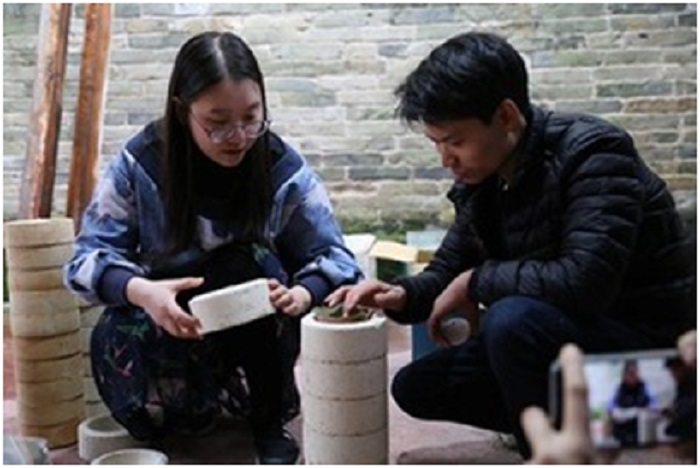



Tu Jinge and Yu Huihui, graduates from Nankai University in China, have dedicated themselves to revitalizing traditional techniques in making porcelain leaf cup, a traditional craft originated in Ji’an, east China’s Jiangxi province.
As an unique invention of Jizhou Kiln, a famous porcelain kiln in ancient China, the porcelain leaf cup making techniques featuring the integration of a whole tree leaf into porcelain ware, have a history of over 1,200 years and have been included into China’s national list for intangible cultural heritage.
Tu first met porcelain leaf cups in 2016, when she was a postgraduate student of the College of Tourism and Service Management of Nankai University.
She was deeply impressed by the craft, thinking that it was indescribably wonderful that after being burned in the kiln, natural leaves emerged unscathed and integrated into the porcelains.
The post-90s postgraduate student then became enchanted by the intangible cultural heritage.
In the same year, Tu and her friend Yu Huihui took a trip to the ruins of the ancient Jizhou Kiln located in Yonghe township, Ji’an county, Ji’an city of Jiangxi province, trying to learn more about the techniques behind the special leaf cups.
During the trip, they came across Wen Qiu, a post-80s craftsman engaging in making porcelain leaf cups, and learned that the craft was facing gloomy development prospects due to unstable output and quality, as well as a lack of marketing channels.
Such marvelous works of art and exquisite craftsmanship deserve to be seen by more people, thought Tu, who decided to make efforts and help promote the intangible cultural heritage.
The main reason why intangible cultural heritage seems far away for ordinary people is that the design of relevant products doesn’t suit the market, they thought.
“We hope to innovate designs and then sell the products through e-commerce platforms,” Yu said.
They encouraged Wen, who is skilled at developing colors of glaze, to create new types of glaze and helped him select pigments for the new glaze.
Finally, they decided on an ultramarine glaze. Developed from natural lapis lazuli, the glaze is safe and environment-friendly, and will never fade.
To promote porcelain leaf cups made with the new glaze, they helped make the copy for advertisement and learned photography to better present the products in photos.
One week after the new leaf cup was launched on an e-commerce platform, the sales volume of the product reached 200,000, bringing Wen an income of more than what he earned in the previous three years, while attracting more craftsmen who came to seek cooperation.
Innovation has been a never-ending topic for Tu and Yu in reviving the traditional techniques.
They discovered that some locals use leaves from bodhi trees to make leaf cups, which they believed to be of more artistic value compared with mulberry leaves, main materials for craftsmen for over a thousand years.
Their idea of making porcelain leaf cups with leaves of bodhi trees aroused concerns among craftsmen in their team.
Leaves of bodhi trees are thicker than mulberry leaves, which makes the porcelain firing more difficult than it already is, according to craftsmen, who told Yu and Tu that the township where their workshop is located doesn’t grow bodhi trees.
However, Tu and Yu didn’t give up. They went to collect leaves of bodhi trees from various areas, and finally concluded from observation that the leaves from Zhangzhou, southeast China’s Fujian province, are their best choice for making leaf cups.
When encountering technical problems in firing porcelains, they sought help from experts of Nankai University.
After several months’ experiment, they eventually succeeded in making leaf cups with the leaves of bodhi trees.
To facilitate the sales of their products, Tu started to host live-streaming shows.
“Although we may not have many viewers sometimes, we still promote our products passionately in front of the camera as we have faith in leaf cups,” Tu noted.
Once a customer bought over 100 leaf cups after learning about the product via a live-streaming show hosted by Tu, she recalled.
The elaborately-decorated leaf cups have conveyed the splendid tea culture and art of China.
“By encouraging local craftsmen to exhibit their products at cultural activities, we hope to build a stronger and more famous brand for the special ware from Jizhou Kiln,” Yu pointed out.
In 2019, when Nankai University celebrated its centenary, Tu and Yu designed a special leaf cup featuring ginkgo leaf from the university, thus opening up the market for customized designs.
In the past three years, they have hosted over 800 live-streaming shows and sold porcelain leaf cups worth over 3.5 million yuan ($540,000).
Together with 18 inheritors of the craft, they have engaged in innovation and increased the number of the types of leaves used in the product from one to eight, and the colors of glaze from one to 16. Meanwhile, they have developed 27 shapes and over 1,000 different designs for leaf cups.
After their graduation in 2019, Tu and Yu continued to promote the intangible cultural heritage.
Last year, they participated in the 6th China International College Students’ “Internet+” Innovation and Entrepreneurship Competition and won a silver award in the final of the competition.
Intangible cultural heritage enjoys a huge market and infinite possibilities, Tu said.


Senator Chuka Utazi who represented Enugu.


An Abuja based Legal Practitioner, Ugochukwu.


The African business community in Yiwu,.


Anti – kidnapping, Human Trafficking, Child.


The All Farmers’ Association of Nigeria.


The police on Tuesday arraigned a.


As part of measures to further.


Presidential Support C’ttee hails Ganduje’s emergence.


In response to the impact of.
A prayer group in Nigeria under.
Leave a Comment